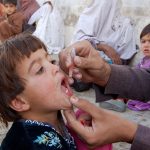 Since the global switch from the trivalent oral polio vaccine to the bivalent oral polio vaccine, fewer countries detected poliovirus type 2 in patient and environmental samples, according to a recent MMWR.
Since the global switch from the trivalent oral polio vaccine to the bivalent oral polio vaccine, fewer countries detected poliovirus type 2 in patient and environmental samples, according to a recent MMWR.
Ousmane M. Diop, PhD, of WHO’s polio eradication department, and colleagues reported that there has been substantial progress against polio since the launch of the Global Polio Eradication Initiative (GPEI) in 1988. Only 37 cases of wild poliovirus type 1 were reported in 2016, which is the lowest annual count to date. Moreover, cases of wild poliovirus type 3 have not been reported since November 2012, and wild poliovirus type 2 (PV2) was declared eradicated in September 2015.
Although this progress has been attributed to the wide use of live oral poliovirus vaccines (OPVs), there have been numerous outbreaks caused by vaccine-derived polioviruses (VDPVs), according to the researchers. In 2015, VDPV type 2 (VDPV2) outbreaks occurred in Nigeria, Pakistan, Guinea, Burma and South Sudan, and VDPV2 single events occurred in 22 countries, prompting the GPEI to withdraw the trivalent OPV (tOPV), designed to protect against all three poliovirus types. In April 2016, all OPV-using countries switched to the bivalent OPV (bOPV), which protects against the two remaining wild polio strains. The vaccine switchover is the first stage of a larger plan to withdraw all OPVs.
Following the tOPV withdrawal, the GPEI monitored the disappearance of PV2 in human populations and the environment through the Global Polio Laboratory Network and several surveillance systems. Researchers used a new molecular diagnostic assay and algorithm developed by the CDC to assess approximately 208,000 stool specimens and sewage samples.
Before the global switch, PV2 was detected in 46 countries from January to April 2016. Since then, researchers observed a decline in the number of countries with PV2. The virus was identified in 22 countries from May to August 2016, eight countries from September to December 2016, and seven countries (Afghanistan, Cameroon, Chad, Mozambique, Niger, Nigeria and Pakistan) from January to March 2017. Field investigations revealed breaches in tOPV or monovalent OPV type 2 (mOPV2) withdrawal in India, Pakistan, Afghanistan, Russia, Iraq, Nigeria and Cameroon.
“Response to these breaches included development of guidelines for investigation and implementation of corrective actions to ensure the safe disposal of all tOPV vials,” the researchers wrote. “For example, in India, the National Polio Surveillance Program established a policy to replace any tOPV vial found in private clinics with two bOPV vials as an incentive for finding and reporting tOPV vials.”
All countries, except Afghanistan, with PV2 in 2017 distributed the mOPV2 vaccine during immunization campaigns in response to the detection of VDPV2 isolates in Pakistan and Nigeria. PV2 detected in Afghanistan was linked to use of the vaccine in a neighboring district of Pakistan.
“Lessons learned from surveillance for PV2 after the global synchronized withdrawal of the PV2 component from vaccines have resulted in development of standardized procedures for investigation of PV2 detection in humans and the environment, and handling PV2 in diagnostic laboratories,” Diop and colleagues wrote. “These lessons will guide the elimination of OPV1 and OPV3 once eradication of polio has been certified.”
Source: Healio

















